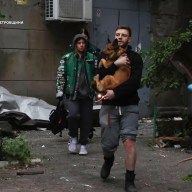Since the release of his 2009 film, “Bruno,” comic actor and writer Sacha Baron Cohen has largely stayed out of the spotlight. But two years of hermitage draw to a close as Baron Cohen promotes “Hugo,” the new Martin Scorsese 3-D film about young tinkerer Hugo Cabret who meets legendary filmmaker Georges Méliès in 1930s France. Baron Cohen plays the station inspector who is onto the orphaned boy, who makes his home in the clock towers of the rail station. Baron Cohen recently spoke on working with legendary filmmaker Martin Scorsese for the film and his own creative contributions to the process.
We’re used to seeing your irreverent and subversive side, so what was this different
direction like for you to play an authority figure and a sexually inhibited person?
Who said I was inhibited in this? I have a bath with a dog [in the film]. What happened beneath the bubbles is our business. There is a bit of romance between myself and Emily [Mortimer’s] character, which is actually the first romantic plot I’ve had that’s not been with a black prostitute or a man. So, that was a little bit different. As for playing an authority figure, he’s a bumbling authority figure and he’s dark but he does have some beauty and softness underneath him. A bit like my other characters, he’s a mix of things. Does that answer it? We can talk more about the bath if you want.
Did you consider your character’s backstory?
Yes. Certainly, when I approached the character of the station inspector, I wanted to know, “why was he so obsessed with chasing children and was he actually a classic villain or was there reason for his malice?” We started to think perhaps he was a World War I veteran and maybe he was injured, so that’s where we got the idea of the leg brace. Originally, it was a false leg. It was going to be the first chase and then I was going to turn a corner and then my leg was going to fly off into camera in 3-D … [But] we kind of realized that maybe he himself was an orphan and was put away to the work house and that’s the only structure he knew. That’s what he’s trying to impose on these young children.
Where did you find the magic in this film?
It felt like it was the logical extension of filmmaking, that if Méliès was alive, that he definitely would’ve been using 3-D. That was the interesting thing because of the whole debate in cinema at the moment, whether 3-D is a gimmick or not. Scorsese really showed that it was a logical development of the filmmaking process.
How was working with Martin Scorsese?
He’s totally collaborative, which I was surprised about because I expected him to be some incredible auteur — which he is — but part of his power and part of the reason why his films are that successful and that enduring is the fact that he’s ready to collaborate fully with all of his actors. Any idea that I came up with, he was ready to listen to. Surprisingly, because I came up with some really absurd ideas, he was ready to try them out, which was worrying for the producer and the financiers of the movie but for me, it was great.

















